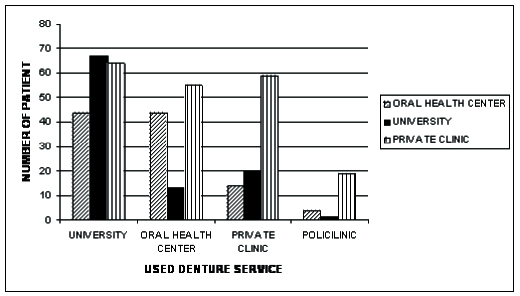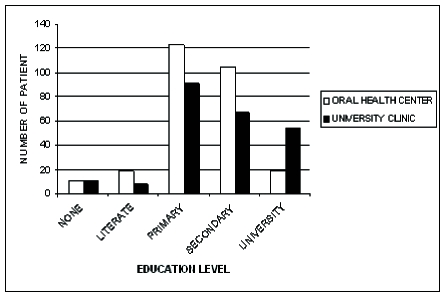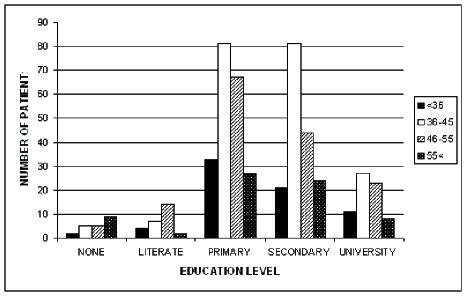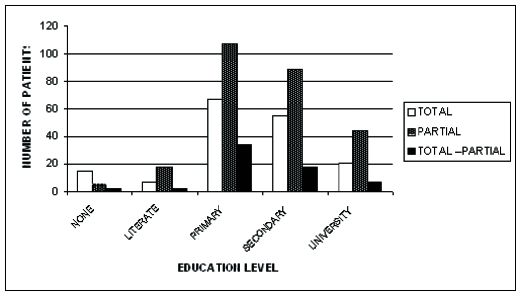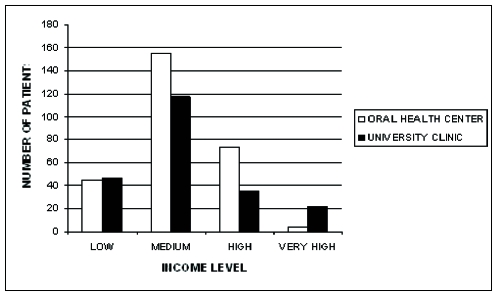Abstract
Objectives
The aim of this study was to evaluate relationships between the socio-demographic and economic factors of patients and the reasons of admission, usage periods of the two types of clinics, frequencies of denture changes, satisfaction levels and preferences of prosthetic dental treatment.
Materials and Methods
510 partially and/or totally edentulous patients were studied using a questionnaire. The questionnaire consisted of questions; age, gender, education level, income status, problems with dentures, necessity for new dentures. Also asked was the place that the subjects would prefer to get their denture treatment, irrespective of their income level. In this study, Z-test was used to analyze two-sample proportions, T-test was used to determine two-sample means and Chi-square test was used to determine relationship between two classified variables.
Results
The number of male patients with complete dentures was more than the number of females, with an opposing trend for partial dentures. Irrespective of gender, each patient had had nearly two dentures by the time of questioning. It was also observed that the university clinics were generally preferred by patients from higher income levels with a higher educational level (x2=25.206, P<.00). When patients were asked where they would prefer denture treatment, regardless of cost, private practice was the preferred-choice.
Conclusions
With respect to dental condition and the acceptance of removable dentures, there were differences among gender, educational level and income status.
Keywords: Removable denture, Socio-demographic factors
INTRODUCTION
Edentulism can substantially affect oral and general health as well as the overall quality of life.1,2
A recent national survey of a United States population estimated that the mean tooth loss in subjects aged 30–34 and 60–64 years was 2.6 and 13.2 teeth, respectively.3 A national survey of a United Kingdom population found 6.6 and 9.5 missing teeth among 35–44 and 45–54 years old, respectively.4 Comparisons with other studies show that tooth loss is higher than that reported for the populations of Brazil, China and Kenya.5–7
Total or partial edentulism is a good indicator of the oral health of a population.8,9 The prevalence and extent of tooth loss has decreased significantly in many developed countries during recent decades.3,10,11 Some studies have reported that the incidence of edentulism correlates with educational level and income status, with those in lower levels exhibiting higher risks of becoming totally edentulous.1,9
Of particular interest are the changes in edentulism that occurred in the population between the ages of 65 and 74. Some authors have suggested that, by the year 2020, less than 15% of the population will be edentulous. This would be in keeping with the decrease in edentulism that has occurred over the past few decades.12
The problem associated with edentulousness is that it is a common condition which affects 20–25% of the entire adult population, with increasing figures in elderly groups. For example, roughly 1½-2 million people lack natural teeth in one or both jaws in Sweden. It has also been estimated that 5–10%, about 100,000 adults, of those with edentulism have great difficulties in tolerating dentures for one reason or another. Corresponding figures for the US indicate that there are more than 20 million edentulous people, with 1–2 million subjects that have adaptation problems to removable dentures.13
In Turkey, there is no complete dental insurance. However, basic treatment items, such as tooth extractions, filling and periodontal treatment are included in the Turkish general health insurance. For more comprehensive treatments, such as prosthodontic services, patients or their private insurance providers must pay in half of the cost.
Studies evaluating the oral health and the considerations of treatment of oral health may be successful only with the common effort of dentists, educators, politicians and the dental industry.
Of special importance, the Turkish prosthetic dental treatment is practiced at universities, state hospitals (oral health centers) and by private practitioners.
The aim of the present study is to describe the different dental conditions in the younger population of Turkey and to analyze the patterns of socioeconomic and attitude-related factors associated with dental conditions at an oral health center and the Department of Prosthodontics at Kırıkkale University. The relationships among the socio-demographic and economic factors of patients and the reasons of admission, usage periods of the two types of clinics, frequencies of denture changes, satisfaction levels and preferences of prosthetic dental treatment are statistically evaluated.
MATERIALS AND METHODS
This study was performed on patients who applied for complete or partial denture treatment at the Oral Health Center of Ministry of Health (OHC) and the Department of Prosthodontics, Faculty of Dentistry, Kırıkkale University. The study group consists of 510 patients, 233 of whom (45.7%) applied to the university clinic and 277 (54.3%) that applied to OHC. The participants of this study were 510 patients, aged 50 years and over. The ages of the participants ranged from 56 to 58 (mean 57.21 yrs) in males and from 53 to 55 (mean 54.55 yrs) in females.
A 10 item questionnaire not including private questions such as name, address, etc; were presented to 510 randomly selected subjects among the patients who applied for removable prosthetic treatment at the OHC and university clinic. The questionnaires were conducted face-to-face between subjects and the dentists who planned this study. The questionnaires was constructed from an analysis of the literature detailing variables describing prosthetic needs and standards of life associated with oral health.14,15 In the present study the following 10 variables were used.
General and dental health insurance.
Application for removable prosthetic treatment at the OHC and the university clinic.
Gender; male or female.
Education; none (no education), literate without diploma, primary (<11 years), secondary (>12 years) and university or higher.
Economic status; low, medium, high or very high. There has not been a consensus on various socio-economic classifications in Turkey because of the unstructured nature of society. Therefore, for the purpose of this study, the standard occupational classification system designed by the Office of Population Census and Surveys, London (OPCS1994)14 and Prime Ministry of the State Institute of Statistics, Republic of Turkey (DIE)15 (modified based on local conditions), was used and patients were classified into socio-economic groups.
Denture prevalence; fixed partial denture, removable partial and/or complete denture.
The number of prosthetic dentures used; how many removable dentures do you wear?
Problems with dentures; aesthetics, maladjustment, broken denture and satisfaction with denture.16
Most common problems related to previous denture type.
Preferred location of dental service, regardless of cost.
Statistical analysis
Data was analyzed using frequency distributions tables and figures. The responses were evaluated with different statistical methods according to the types of questions. In this study, z-test was used to evaluate two-sample proportions, t-test was used to evaluate two-sample means and chi-square tests were used to evaluate the relationship between two classified variables.
RESULTS
Partial denture treatment was applied to a majority of the 510 patients. The number of the male patients with complete dentures was more than the number of female patients, with an opposite result for partial dentures. For patients participating in the questionnaire, the proportion of complete denture was observed to be 38.3% for males and 28.7% for females. Therefore, the proportion of complete dentures between males and females was significantly different, the proportion of males was about 10% more than the proportion of females (P=.0232). Moreover, of the patients having partial dentures, 49.0% were male and 58.3% were female. The difference was statistically significant (P=.037). With respect to gender, the proportion of removable denture was 13.0% and 12.7% for males and females, respectively. The difference was not statistically significant (P=.920) (Table 1).
Table 1.
Patient number and percentage distribution by gender, educational level, income level and applied denture type.
| Applied Denture | Gender
|
Educational Level
|
Income Level
|
||||||
|---|---|---|---|---|---|---|---|---|---|
| Type | Male | Female | None | Primary | Secondary | University | Low | Medium | High |
| Complete | 94
38.3% |
71
28.7% |
22 | 67 | 55 | 21 | 118 | 42 | 3 |
| Partial | 120
49.0% |
144
58.3% |
23 | 107 | 89 | 44 | 186 | 61 | 9 |
| Comp./Part. | 31
12.7% |
32
13.0% |
4 | 34 | 18 | 7 | 47 | 12 | 3 |
| Total | 245 | 264 | 49 | 208 | 162 | 72 | 351 | 115 | 15 |
The relationship between patient’s gender and the most frequently faced problem associated with denture wearing, including maladjustment, breakage, unpleasant esthetics, allergic reactions, tooth loss, corruption of supportive teeth, etc was investigated. The most frequently faced problems were maladjustment (36.9%) and broken denture (11.9%). These two problems were not associated with gender. However, esthetic problems are observed nearly twice as often in female patients than in male patients. Overall, the relationships between gender and patients’ complaints were not statistically significant (x2=7.621, P=.055). There is not a statistically significant relationship between gender and the reasons for requiring new dentures (x2=6.794, P=.236). However, some reasons, including fractured denture, broken connector and denture incompatibility, seem to occur more frequently in male patients. Female patients require removable dentures due to tooth loss and other reasons, as seen in Table 2.
Table 2.
Patient number and percentage distribution by gender and problems with reason for require new denture.
| Denture problems | Gender
|
Total | |
|---|---|---|---|
| Male | Female | ||
| Maladjusment | 79
41.4% |
61
32.4% |
140
36.9% |
| Broken | 24
12.6% |
21
11.2% |
45
11.9% |
| Aesthetic | 7
3.7% |
18
9.6% |
25
6.6% |
| Satisfied | 81
42.4% |
88
46.8% |
169
44.6% |
| Total | 191 | 188 | 379 |
| Reasons for require
| |||
| Broken of denture | 32
59.3% |
22
40.7% |
54
100% |
| Tooth loss | 88
47.6% |
97
52.4% |
185
100% |
| Missing denture | 1
50.0% |
1
50.0% |
2
100% |
| Broken of connecture | 5
55.6% |
4
44.4% |
9
100% |
| Denture incompatibility | 62
55.4% |
50
44.6% |
112
100% |
| Other | 6
30.0% |
14
70.0% |
20
100% |
| Total | 194
50.8% |
188
49.2% |
382
100% |
If patients had enough income, 46.1% would prefer private clinics. Of the patients who had previously received dental treatment in university clinics, 38.3% would prefer university clinics again. The counterpart proportion of the OHC patients was 47.8%. University clinics and OHC lose their patients because the ratio of preference for these locations is less than 50%. Patients who received dental service at private clinics prefer the same places (63.4%). Patients who used policlinic services also prefer private clinics 79.2%. Consequently, if patients have enough income, they mostly prefer private clinics, as seen in Figure 1 (x2=5.6884, P<.001).
Figure 1.
Histogram of patients used denture service by preferred of dental service.
Questionnaires were given at OHC and at a university clinic. The education level of patients who applied to OHC was mostly at primary and secondary school levels. Most of the patients who applied to the university clinic had secondary school and a university degree, as seen in Figure 2 (P<.001).
Figure 2.
Histogram of patients applied center by education level.
With respect to when the first removable denture treatment was received, there was a significant relationship between education level and age (x2=25.854, P=.011). It was also observed that most of the patients in the “none” education group received their first prosthetic application after 56 years of age. The corresponding age range for the illiterate group was 46–55. Those patients having a primary or greater education level generally need their first denture treatment at the age of 36, as seen in Figure 3.
Figure 3.
Histogram of educational level by first removable denture treatment age.
In this study; a significant difference was found between educational level and the type of last denture. The patients having no education had a total denture, whereas the patients of other education levels had a partial denture (x2=18.395, P=.018) (Figure 4).
Figure 4.
Histogram of education level by denture type.
There seems to be a significant relationship between income and the center where the patients went for removable denture treatment. Low-income patients applied to the OHC (49%) and the university clinic (51%) whereas, middle and high income groups applied mostly to the OHC. However, patients in the very high income level mostly went to the university clinic (85%) (x2=25.206, P<.001), as seen in Figure 5.
Figure 5.
Histogram of income level by applied center.
DISCUSSION
Since much of the tooth loss results from periodontal disease and dental caries, tooth loss is a reliable measure of a population’s oral health status.12,17 In recent decades, the prevalence and extent of tooth loss have decreased in many countries.3,10 This decline may be attributed to the increase in the awareness of the importance of oral health in the population.18 The relationship between tooth loss and the need of prosthetics is highly complex. In the dental literature, there are different ways of determining socio-economic status and the needs of prosthetics. There is no information on the rate of tooth loss and prosthetic needs in Turkey. This study was undertaken to assess the prevalence and extent of denture use while also evaluating associated demographic factors such as gender, socio-economic status and educational level in two different clinics.
In this study, the data for the patients who applied to the OHC and university clinic for prosthetic dental treatment were statistically evaluated. The 510 patients who participated in the questionnaire were randomly selected. These questionnaires, consisting of 10 questions, were presented to the patients personally by the dentists who planned this study. Patients were not guided in any way and their personal information was not recorded.
Mattin and Smith,19 who worked on Asians living in England in 1991, examined the dental cases of 1995 people and reported that 70% of the subjects used removable dentures. They also reported that fifteen percent of these patients went to a dentist regularly while the others went to a dentist when they had a problem with their removable denture.19 In the current study, patients who joined this study mostly had partial dentures.
Most studies have shown significant gender differences in edentulism, with more males becoming edentulous than females.20–22 On the contrary, Marcus et al8 observed that the prevalence of edentulism had no relationship with gender. In the present study woman requested mainly partial dentures whereas men mostly requested complete dentures. It was shown that complete dentures were provided to more males than females. In addition, Marcus et al8 indicated that the older age groups required more removable complete dentures than the younger age groups, while the younger age groups required more removable partial dentures. Of particular interest are the changes in edentulism that occurred in the population aged 65 to 74 years between 1958 and 1971. Approximately 10% more adults in this age group were edentulous in 1971 when compared to the same group in 1958.8 An earlier study showed that there was a need for the replacement of 24% of complete dentures and 55% of removable partial dentures in patients who were 60 years old.17 The present study showed that removable denture treatment was given to younger patients (the female group was 53.73 years old and male group was 57.28). This has been attributed to the fact that males have a more active life-style than females, and also that the males do not pay adequate attention to oral care.
When the average number of dentures applied to the patients who participated in the study were evaluated, female patients had an average of 2.29 denture treatments and male patients had an average 2.37 denture treatments; indicating that women require their dentures less than men, with a small difference. On the other hand, with this observation, the prejudice of “females have more denture treatments than males” can not be supported.
Findings of several studies show a higher tooth loss in females than males.4–7,11 In contrast, within the UK population, tooth loss was similar in the two gender groups.8 The present study is about prosthetic needs with regard to the national pattern of decreasing edentulism in Turkey. It was determined that socioeconomic status and low educational level were negatively associated with edentulism; this conclusion is similar to the results of previous studies.1,2,9,12,23
Studies of removable dentures wearers revealed that between 20% and 30% were dissatisfied with one or both dentures. For new and well-constructed dentures, between 10% and 15% of the patients were still dissatisfied.24,25 Silverman et al26 claimed that males accepted their dentures best. Barenthin27 found that women were somewhat more sensitive than men to the condition of their dentures. In the current study, the data indicated that women (46.8%) and men (42.4%) were satisfied with their dentures. When gender and the complaints from dentures were evaluated together, there did not seem to be a significant difference between maladjustment and broken denture complaints. The complaints about aesthetics were seen mostly among females. The reasons of tooth loss and denture incompatibility did not depend on gender. In this case, the patients requested denture treatment only when necessary.
John et al28 reported that partial dentures were more tolerable than their complete counterparts. If the prior denture types and the patient complaints were evaluated together, patients wearing partial dentures were generally pleased with the conservatism and functionality expected from partial dentures. The older age groups in the present study required more removable complete dentures than the younger age groups, who required more removable partial dentures. Patients who used complete dentures had various complaints, including maladjustment, incompatibility and excessive moving of total dentures. This is an expected situation because total dentures are only tissue supported. In the prosthetic treatment decision making process, a patient-clinician dialogue is important in achieving an optimal treatment result. If expensive prosthetic treatments (e.g. implant treatments) are made financially available for all individuals by means of subsidies, this can influence the existing needs and create a new need among the population.
The results also showed that the education level of patients who applied at the OHC for treatment were at primary or secondary school levels. Most of the patients who applied at the university clinic had secondary school or a university degree. In the previous studies, the patients who had no education had a total denture and other education levels had a partial denture. Also, previous studies have reported the same-association between educational levels and general and/or oral health.5,29–31
In addition, there seems to be significant relationship between income status and the treatment center where the patients apply. Low-income patients applied to the OHC (49%) and the university clinic (51%), while middle and high income groups applied mostly to the OHC. However, patients with very high income status mostly go to the university clinic. In this study, dental care was significantly associated with gender, age, level of education and income status. These results are in accordance with several other studies.5,22,29,32–34
CONCLUSIONS
This study clearly revealed that edentulism is dependent on a combination of various factors, including socio-demographic status, education level, income situation and socio-economic condition. The results of this study showed that the present possibilities should adequately be determined to constitute a base for further comparative studies, and an evaluation of the long term dental-care-system was necessary.
REFERENCES
- 1.Iacopino AM, Wathen WF. Geriatric prosthodontics: an overview. Part I. Pretreatment considerations. Quintessence Int. 1993;24:259–266. [PubMed] [Google Scholar]
- 2.Iacopino AM, Wathen WF. Geriatric prosthodontics: an overview. Part II. Treatment considerations. Quintessence Int. 1993;24:353–361. [PubMed] [Google Scholar]
- 3.Marcus SE, Drury T, Brown LJ, Zion GR. Tooth retention and tooth loss in the permanent dentition of adults: United States 1988–1991. J Dent Res. 1996;75:684–695. doi: 10.1177/002203459607502S08. [DOI] [PubMed] [Google Scholar]
- 4.Downer MC. The improving dental health of United Kingdom adults and propects for the future. Br Dent J. 1991;170:154–158. doi: 10.1038/sj.bdj.4807452. [DOI] [PubMed] [Google Scholar]
- 5.Susin C, Oppermann RV, Haugejorden O, Albandar JM. Tooth loss and associated risk indicators in an urban population from south Brazil. Acta Odontol Scand. 2005;63:85–93. doi: 10.1080/00016350510019694. [DOI] [PubMed] [Google Scholar]
- 6.Lin HC, Cobet EF, Lo ECM, Zhang HG. Tooth loss, occluding pairs, and prosthetic status of Chinese adults. J Dent Res. 2001;80:1491–1495. doi: 10.1177/00220345010800052101. [DOI] [PubMed] [Google Scholar]
- 7.Manji F, Baelum V, Fejerskov O. Tooth mortality in an adult rural population in Kenya. J Dent Res. 1988;67:4496–4500. doi: 10.1177/00220345880670021301. [DOI] [PubMed] [Google Scholar]
- 8.Marcus PA, Joshi A, Judith AJ, Morgano SM. Complete edentulism and denture use for elders in New England. J Prosthet Dent. 1996;76:260–266. doi: 10.1016/s0022-3913(96)90169-9. [DOI] [PubMed] [Google Scholar]
- 9.Brodeur JM, Benigeri M, Naccache H, Olivier M, Payette M. Trends in the level of edentulism in Quebec between 1980 and 1993. J Can Dent Assoc. 1996;62:162–166. [PubMed] [Google Scholar]
- 10.Brown LJ. Tends in tooth loss among US employed adults from 1971 to 1985. J Am Dent Assoc. 1994;125:533–540. doi: 10.14219/jada.archive.1994.0096. [DOI] [PubMed] [Google Scholar]
- 11.Österberg T, Carlsson GE, Sundh W, Fyhrlund A. Prognosis and factors associated with dental status in the adult Swedish population. Community Dent Oral Epidemiol. 1995;23:232–236. doi: 10.1111/j.1600-0528.1995.tb00237.x. [DOI] [PubMed] [Google Scholar]
- 12.Weintraub JA, Burt BA. Oral health status in the United States:Tooth loss and edentulism. J Dent Educ. 1985;49:368–378. [PubMed] [Google Scholar]
- 13.Alberktsson T, Blomberg S, Branemark A. Edentulousness an oral handicap. Patient reactions to treatment with jawbone anchored prostheses. J Oral Rehabil. 1987;14:503–511. doi: 10.1111/j.1365-2842.1987.tb00746.x. [DOI] [PubMed] [Google Scholar]
- 14.Office of Cersus and Surveys (OPCS 1994) Standart occuppational Classifications. Vol. 3. London: HMSO; [Google Scholar]
- 15.htttp://www.die.gov.tr/konularr/kazanc.htm
- 16.Knezovic Zlataric D, Celebic A, Valentic-Peruzovic M, Jerolimov V, Panduric J. A survey of treatment outcomes with removable partial dentures. J Oral Rehabil. 2003;30:847–854. doi: 10.1046/j.1365-2842.2003.01039.x. [DOI] [PubMed] [Google Scholar]
- 17.Lenz E. Epidemiological evaluation of edentulousness and the need for prosthodontic care. In: Künzel Walter., editor. Geriatric Dentistry in Eastern European countries. Berlin: Quintessence Publishing; 1991. pp. 53–65. [Google Scholar]
- 18.Loe H. Oral hygiene in the prevention of caries and periodontal disease. Int Dent J. 2000;50:129–139. doi: 10.1111/j.1875-595x.2000.tb00553.x. [DOI] [PubMed] [Google Scholar]
- 19.Mattin D, Smith JM. The oral health status, dental needs and factors affecting utilisation of dental sevices in Asians aged 55 years and over resident in Southampton. Br Dent J. 1991;170:369–372. doi: 10.1038/sj.bdj.4807551. [DOI] [PubMed] [Google Scholar]
- 20.Hoover JN, McDermott RE. Edentulousness in patients attending a university dental clinic. J Can Dent Assoc. 1989;55:139–140. [PubMed] [Google Scholar]
- 21.Suominen-Taipale AL, Alanen P, Helenius H, Nordblad A, Uutla A. Edentulism among Finish adults of working age. Community Dent Oral Epidemiol. 1999;27:353–365. doi: 10.1111/j.1600-0528.1999.tb02032.x. [DOI] [PubMed] [Google Scholar]
- 22.Shah N, Parkash H, Sundream KR. Edentulousness, denture wear and denture needs of Indian elderly- acommunity-based study. J Oral Rehabil. 2004;31:467–476. doi: 10.1111/j.1365-2842.2004.01260.x. [DOI] [PubMed] [Google Scholar]
- 23.Caplan DJ, Weintraub JA. The Oral health burden in United States:a summary of recent epidemiologic studies. J Dent Educ. 1993;57:853–862. [PubMed] [Google Scholar]
- 24.Berg E. The influence of some anamnestic, demographic, and clinical variables on patient acceptance of new complete dentures. Acta Odontol Scand. 1984;42:119–127. doi: 10.3109/00016358409035249. [DOI] [PubMed] [Google Scholar]
- 25.Berg E, Johnsen TB, Ingebretsen R. Psychological variables and patient acceptance of complete dentures. Acta Odontol Scand. 1986;44:17–22. doi: 10.3109/00016358609041293. [DOI] [PubMed] [Google Scholar]
- 26.Silverman S, Silverman SI, Silverman B, Garfunkel L. Self-image and its relation to denture acceptance. J Prosthet Dent. 1976;35:131–141. doi: 10.1016/0022-3913(76)90272-9. [DOI] [PubMed] [Google Scholar]
- 27.Barenthin I. Dental health status and dental satisfaction. Int J Epidemiol. 1977;6:739. doi: 10.1093/ije/6.1.73. [DOI] [PubMed] [Google Scholar]
- 28.John MT, LeResche L, Koepsell TD, Hojoel P, Miglioretti DL, Micheelis W. Oral health-related quality of life in Germany. Eur J Oral Sci. 2003;11:483–491. doi: 10.1111/j.0909-8836.2003.00079.x. [DOI] [PubMed] [Google Scholar]
- 29.Palmqvist S, Söderfelt B, Vigilt M, Kihl J. Dental conditions in middle-aged and older people in Denmark and Sweden: acomparative study of influence of socioeconomic and attitudinal factors. Acta Odontol Scand. 2000;58:113–118. doi: 10.1080/000163500429235. [DOI] [PubMed] [Google Scholar]
- 30.Savolainen J, Suominen-Taipe AL, Hausen H, Harju P, Uutela A, Martelin T, Knuuttila M. Sence of coherence as a determinant of the oral health-related quality of life a national study in Finnish adults. Eur J Oral Sci. 2005;113:121–127. doi: 10.1111/j.1600-0722.2005.00201.x. [DOI] [PubMed] [Google Scholar]
- 31.Lundegren N, Axtelius B, Hakansson J, Aakerman S. Dental treatment need among 20 to 25 year-old Swedes: discrepancy between subjective and objective need. Acta Odontol Scand. 2004;62:91–96. doi: 10.1080/00016350410006941. [DOI] [PubMed] [Google Scholar]
- 32.Osterberg T, Lundgren M, Emilson CG, Sundh V, Birkhed D, Steen B. Utilisation of dental services in relation to socio-economic and health factors in middle-aged and eldery Swedish population. Acta Odontol Scand. 1998;56:41–47. doi: 10.1080/000163598423054. [DOI] [PubMed] [Google Scholar]
- 33.Unell L, Söderfeld B, Halling A, Solen G, Paulander J, Birkhed D. Equality in satisfaction, percieved need and utilisation of dental care in a 50 year old Swedish population. Community Dent Oral Epidemiol. 1996;24:191–195. doi: 10.1111/j.1600-0528.1996.tb00840.x. [DOI] [PubMed] [Google Scholar]
- 34.Reisine ST, Fertig J, Weber J, Leder S. Impact of dental conditions on patients’ quality of life. Community Dent Oral Epidemiol. 1989;17:7–10. doi: 10.1111/j.1600-0528.1989.tb01816.x. [DOI] [PubMed] [Google Scholar]
- 35.htttp://www.saglik.gov.tr/extras/istatistikler/ytkiy2004/



